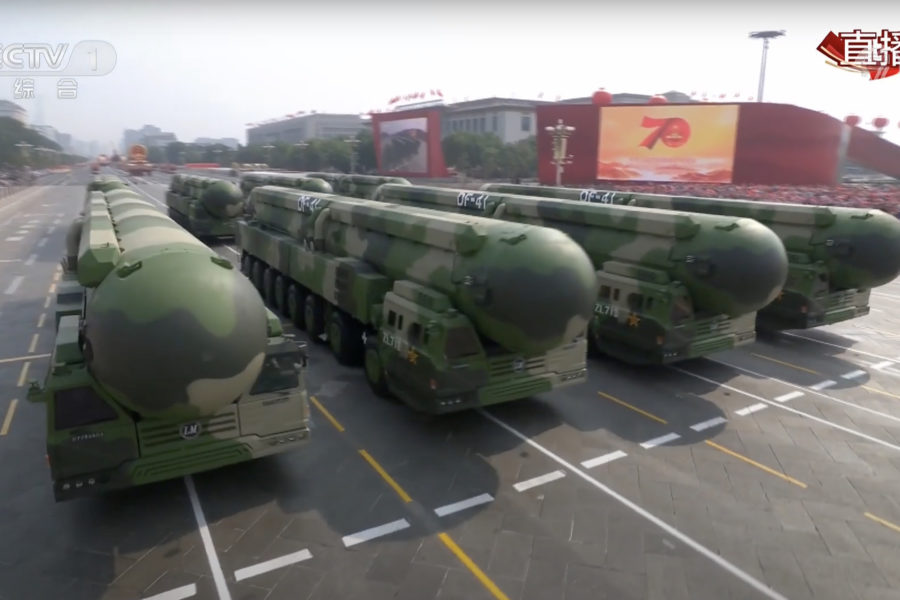Pentagon and Air Force officials have repeatedly warned in recent months that China is making rapid progress in building up its arsenal of nuclear weapons. But as that growth continues, key questions are still unanswered about how the Chinese will structure their strategic forces, according to a new report.
The China Aerospace Studies Institute (CASI) at Air University issued the third edition of its PLA Aerospace Power Primer on Aug. 19, three years after its previous update. And in that time, the People’s Liberation Army’s nuclear capabilities have changed dramatically.
Then-commander of Air Force Global Strike Command Gen. Timothy M. Ray called the growth “breathtaking.” U.S. Strategic Command boss Adm. Charles “Chas” A. Richard termed it a “strategic breakout.” And the Pentagon had to revise its estimates of how many nuclear warheads the Chinese will possess by the end of the decade.
The People’s Liberation Army Rocket Force, which controls China’s nuclear and conventional missiles, “has evolved from a small, unsophisticated force of short-ranged and vulnerable ballistic missiles to an increasingly large, modern, and formidable force with a wide array of both nuclear and conventional weapons platforms,” notes the new CASI primer.
But while much has been made about the increase in silos and warheads, the grand totals still lag far behind the U.S. and Russia, noted Dr. Brendan S. Mulvaney, director of CASI and one of the primer’s authors. China’s new nuclear triad, however, deserves more attention, he said.
“You can say, ‘Oh, my God, they’re tripling their force. It’s a 300 percent increase,’ which is absolutely true,” Mulvaney told Air Force Magazine. “But it’s always been in the Rocket Force, so as you create a submarine force and an air force that are now nuclear capable, of course you’re going to have to increase the number of warheads.
“… But it is very telling that they’re spending that much time and effort in the nuclear forces, and diversifying, right? That’s the part that really makes people, or should make people, pay some attention to that.”
In particular, the beginning stages of China’s nuclear triad raise all sorts of questions for the PLA Air Force and Navy, the report suggests, as neither branch has dealt much with nuclear weapons.
“The open question, which China doesn’t talk much about, is as you build a triad, what are the roles and capabilities that you’re going to have in the air arm?” Mulvaney said. “Because for them, the PLARF have all the ICBMs, right. So traditionally, the PLARF has had control over essentially all the weapons in China for these last couple of decades, for a long time. And so as that changes, what role does the air force … play?”
For now, the report states, the “current role of the PLAAF … is nascent at best due to technical limitations and the relatively small size of its nuclear capable bomber fleet.”
But that may change in the future, particularly if the PLAAF develops its own nuclear command and control procedures and infrastructure, separate from the PLARF, Mulvaney said.
The Chinese could “simply cordon off within the air force and within the navy the nuclear [weapons]-capable portions … and have them create their own direct links, like the PLARF has, but just duplicating one for each service,” Mulvaney said. “So that’s possible, and all that would feed up to the Joint Operations Command Center for the Central Military Commision.”
Such an arrangement would create redundancy and flexibility but might also raise the possibility of poor communication and misunderstandings.
Alternatively, “it’s conceivable that they would come up with something akin to our Strategic Command, in which case, they would start to lump all the nuclear weapons or the nuclear release authorities,” Mulvaney said.
Such an arrangement wouldn’t be perfectly analogous to STRATCOM—“they’re organized differently, their command and control is different, so it’s not a one-to-one ratio,” Mulvaney said—but it would fit with a broader trend he noted in how the Chinese have reformed their military over time.
“Because China doesn’t have any real-world experience, they do a lot of studying other militaries, specifically the United States and our allies and partners,” Mulvaney said. “ … A lot of the changes that they made in 2015 and 2016 were basically to craft a new model kind of like the United States.”
While those questions remain unanswered, Mulvaney said the goal of the primer is to give personnel across the Air Force a basic understanding of China’s military aerospace capabilities, in line with Chief of Staff Gen. Charles Q. Brown Jr.’s Action Order C, which pushes for Airmen “to understand their role in the long-term strategic competitions between the U.S., Russia, and China.”
A digital copy of the primer is available online, and hard copies will be distributed at the U.S. Air Force Academy, Air Command and Staff College, and Air War College, Mulvaney said.

